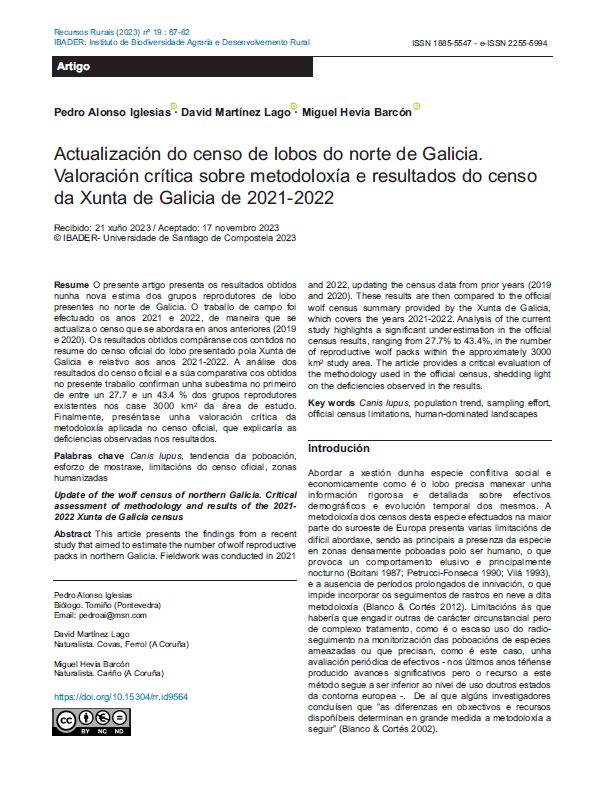Update of the wolf census of northern Galicia. Critical assessment of methodology and results of the 2021-2022 Xunta de Galicia census
Main Article Content
Abstract
This article presents the findings from a recent study that aimed to estimate the number of wolf reproductive packs in northern Galicia. Fieldwork was conducted in 2021 and 2022, updating the census data from prior years (2019 and 2020). These results are then compared to the official wolf census summary provided by the Xunta de Galicia, which covers the years 2021-2022. Analysis of the current study highlights a significant underestimation in the official census results, ranging from 27.7% to 43.4%, in the number of reproductive wolf packs within the approximately 3000 km2 study area. The article provides a critical evaluation of the methodology used in the official census, shedding light on the deficiencies observed in the results.
Keywords:
Article Details
References
Alonso, P., Martínez, D. & Hevia, M. (2021). Censo da poboación de lobos (Canis lupus) do norte de Galicia e estimativa da densidade. Recursos Rurais 17: 39-54.
Álvares, F. (2012). Ecologia e conservação do lobo (Canis lupus, L.) no noroeste de Portugal. Tese de Doutoramento. Universidade de Lisboa, Faculdade de Ciências.
Blanco, J.C. & Cortés, Y. (2002). Ecología, censos, percepción y evolución del lobo en España: análisis de un conflicto. SECEM.
Blanco, J.C. & Cortés, Y. (2012). Surveying wolves without snow: a critical review of the methods used in Spain. Hystrix It. J. Mamm 23(1): 35-48.
Boitani, L. (1987). Dalla parte del lupo. Ed. Mondadori.
Cross, P.C., Almberg, E.S., Haase, C.G., Hudson, P.J., Maloney,S.K., Metz, M.C., Munn,A.J., Nugent, P., Putzeys, O., Stahler, D.R., Stewart, A.C., & Smith, D.W. (2016). Energetic costs of mange in wolves estimated from infrared thermography. Ecology 97(8): 1938-1948. https://doi.org/10.1890/15-1346.1
Fagúndez, J., Lagos, L.,Cortés-Vázquez, J.A., & Canastra, F. (2021). Los caballos salvajes de Galicia. Contexto socioeconómico y beneficios ambientales. El caso de estudio de Galicia en el proyecto Grazelife (Life 18 PRE NL 002).
Fuller, T.K., Mech, L.D., & Fitts Cochrane, J. (2003). Wolf population dynamics. Pp. 161-19 In: Wolves. Behavior, Ecology, and Conservation. L.D. Mech e L. Boitani (Eds.). The University of Chicago Press. Chicago.
Jiménez, J., García, E., Llaneza, L., Palacios, V., González, L.M., García-Domínguez, F. Muñoz-Igualada, J & López-Bao, J.V. (2023). Multimethod, multistate Bayesian hierarchical modeling approach for use in regional monitoring of wolves. Conservation Biology, 30 (4): 883-893. http://doi.org/10.1111/cobi.12685
Jiménez, J., Cara, D., García-Domínguez, F. & Barasona, J.L. (2023). Estimating wolf (Canis lupus) densities using video camera traps and spatial capture-recapture analysis. Ecosphere 14: e4604. https://doi.org/10.1002/ecs2.4604
Kittle, A., Anderson, M., Avgar, T., Baker, J.A., Brown, G.S., Hagens, J., Iwachewski, E., Moffatt, S., Mosser, A., Patterson, B.R., Reid, D.E.B., Rodgers, A.R., Shuter,J., Street, G.M., Thompson, I.D., Van der Vennen,L.M. & Fryxell, J.M. (2015). Wolves adapt territory size, not pack size to local habitat quality. Journal of Animal Ecology 2015. https://doi: 10.1111/1365-2656.12366
Llaneza, L., García, E.J. & López-Bao, J.V. (2014). Intensity of territorial marking predicts wolf reproduction: implications for wolf monitoring. PLoS ONE 9(3): e93015. https://doi.org/10.1371/journal.pone.0093015.
Martí, F. & Pérez, J.J. (2016). Spanish public finances through the financial crisis. Documentos de Trabajo nº 1620. Banco de España.
Mech, L.D. (1970). The Wolf: The Ecology and Behavior of an Endangered Species. University of Minnesota Press.
Merli, E., Mattioli, L:, Bassi, E., Bongi, P., Berzi,D., Ciuti, F., Luccarini, S., Morimando, F., Viviani, V., Caniglia, R., Galaverni, M., Fabbri, E., Scandura, M. & Apollonio, M. (2023). Estimating wolf population size and dynamics by field monitoring and demographic models: implications for management and conservation. Animals 2023, 13, 1735. https://doi.org/10.3390/ani13111735
Petrucci-Fonseca, F. (1990). O lobo (Canis lupus signatus Cabrera, 1907) em Portugal. Problemática da sua conservação. Tese de Doutoramento, Universidade de Lisboa, Lisboa.
Pimlott, D.H. (1960). The use of tape-recorded wolf howls to locate timber wolves. Midwest Wildlife Conference.
Sells, S.N., Keever, A.C., Mitchell, M.S., Gude, J., Podruzny, K., & Inman, R. (2020). Improving estimation of wolf recruitment and abundance, and development of an adaptive harvest management program for wolves in Montana. Final report for Federal Aid in Wildlife Restoration Grant W-161-R-1. Montana Fish, Wildlife & Parks.
Sidorovich, V. & Rotenko, I. (2019). Reproduction biology in grey wolves Canis lupus in Belarus: Common beliefs versus reality. Minsk Chatyry Chverci.
Vilá, C. (1993). Aspectos morfologicos y ecologicos del lobo iberico (Canis lupus l.). Tese de doutoramento. Universitat de Barcelona.
Xunta de Galicia (2022). Censo de lobo ibérico en Galicia. Resumo. Consellería de Medio Ambiente, Territorio e Vivenda. Dirección Xeral de Patrimonio Natural.
Most read articles by the same author(s)
- Pedro Alonso Iglesias, Miguel Hevia Barcon, David Martínez Lago, Wolf population census (Canis lupus) in northern Galicia and density estimate , Recursos Rurais: No 17 (2021)







